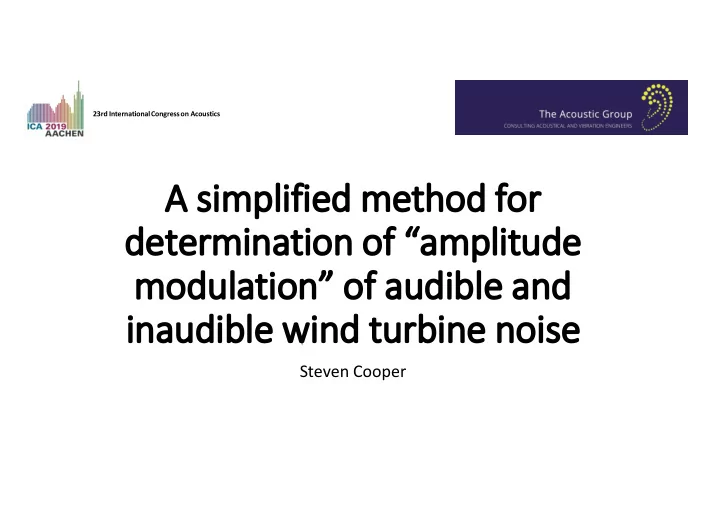

23rd International Congress on Acoustics A simplified A simplified method method for for determination determination of of “amplitude “amplitude modulation” of modulation” of audible audible and and inaudible inaudible wind wind turbine turbine noise noise Steven Cooper
Cape Bridgewater Windfarm Study – Modulation of A-weighted level for different power settings
Simultaneous Inside and Outside Measurements – Leonards Hill Wind Farm (Victoria, Australia) Courtesy of L Huson & Associates
FFT (0-50 Hz, 400 lines) centre upwind (Real) centre upwind (Real) centre downwind (Real) downwind centre (Real) [dB/20u Pa] [dB/20u Pa] 100 100 90 90 80 80 70 70 60 60 50 50 40 40 30 30 20 20 0 5 10 15 20 25 30 35 40 45 50 0 5 10 15 20 25 30 35 40 45 50 [Hz] [Hz] 50% power 14% power
CBW Turbine 13 at 50% power FFT (0-50 Hz, 400 lines) FFT vs Time (0-50 Hz, 400 lines) 1/3 Octave Bands (A-weighted)
Manual Detection of AM • Some methods have used A-weighted levels or peaks in the A-weighted 1/3 octave band spectra to then be subject to assessment in 10 second blocks of time for which the median of the maximum and minimum over a 10 minute sample is used to determine the AM • Other proposals have nominated the use of an FFT analysis of the blade pass frequency but without due consideration of the BT = 1 issue • Based upon a modified Den Brook Methodology the use of 1/3 octave as described above have been used for comparison purposes • On the basis of an A-weighted spectrum, then the criticism of non- compliance with BT = 1 is reduced because of the attenuation of the A- weighting filter
25 Hz 1/3 octave band time trace and movie plot of turbine 25 Hz 1/3 Octave Band Time Splice CPB vs. Time (1/3 octave bands)
Modulation Indices derived from alternative method (A-weighted spectra)
Modulation Indices derived from alternative method (linear spectra)
Comparison of Modified Den Brook Method and Simplified Statistical Method
Recommend
More recommend